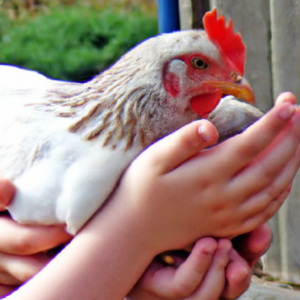
Are your chickens behaving unusually and showing signs of broodiness? If you’re wondering how to identify and manage these behaviors, look no further. This article will guide you through the process, helping you understand the signs of broodiness and providing effective strategies to manage it. With this knowledge, you’ll be able to support your chickens’ well-being and ensure a healthy flock.

Understanding Broody Behavior
Broody behavior refers to the natural instinct of a hen to sit on and incubate her eggs until they hatch. This behavior is driven by hormones and is characterized by physical and behavioral changes in the chicken. Understanding broody behavior is essential for chicken owners to effectively manage their flock and maintain optimal egg production.
Definition of Broodiness
Broodiness is the state of being in which a hen desires to hatch eggs and take care of the resulting chicks. During this time, the hen becomes highly protective of her nest and can exhibit aggressive behavior towards anyone who interferes. This behavior is marked by constant sitting on the nest, fluffing of feathers, and a distinctive clucking sound.
Reasons for Broodiness
There are several reasons why chickens exhibit broody behavior. One common reason is the desire to reproduce and raise offspring. The natural instinct to incubate eggs and care for the chicks is deeply ingrained in chickens. Another reason for broodiness is environmental factors such as warmer temperatures or longer daylight hours. Certain breeds of chickens are also more prone to broodiness due to genetic factors.
Identifying Broody Behaviors
Identifying broody behaviors in chickens is important to ensure proper management and care of the flock. There are both physical signs and behavioral indicators that can help you identify broody hens.
Physical Signs
Broody hens often exhibit specific physical signs that indicate their broody state. These signs include puffing up their feathers, especially around the neck and back, and maintaining a constant sitting position on the nest. Their combs and wattles may become paler, and they may lose weight due to reduced feeding and drinking. Additionally, broody hens often pluck feathers from their chests to provide better contact with the eggs.
Behavioral Indicators
Observing the behavior of your hens can also provide important clues about broody behaviors. Broody hens tend to be highly protective of their nesting area and can become aggressive towards other chickens or even humans who approach. They may also make a distinct clucking sound and exhibit a sense of urgency when returning to the nest after venturing out for food or water.

Effects of Broodiness
Broody behavior can have various effects on both the individual hen and the overall flock dynamics. Understanding these effects is crucial for managing broody behaviors effectively.
Impact on Egg Production
When a hen goes broody, she stops laying eggs. This is because her focus shifts from egg production to incubating the eggs she is sitting on. As a result, broody hens can significantly reduce the egg yield of a flock. This reduction in egg production can have economic implications for commercial chicken owners and may also impact individuals who rely on their backyard flock for a regular supply of fresh eggs.
Vulnerability to Health Issues
During the broody period, hens may spend prolonged periods of time on the nest, leading to decreased physical activity. This sedentary behavior can make broody hens vulnerable to health issues such as obesity, muscle weakness, or even the development of egg-bound conditions. Proactive measures must be taken to ensure the health and well-being of broody hens, as neglecting their needs can have dire consequences.
Managing Broody Behaviors
Once broody behaviors are identified, it is crucial to manage them effectively to maintain the overall productivity and well-being of the flock. There are several strategies that can be employed to manage broody behaviors in chickens.
Allow Natural Incubation
If you intend to hatch eggs, allowing a broody hen to carry out the natural incubation process is an ideal approach. Broody hens have a high success rate in hatching and raising chicks. By providing a suitable environment and necessary resources, you can harness the hen’s natural instincts and encourage successful reproduction.
Using a Broody Hen
In cases where you do not wish to hatch eggs, a broody hen can still be beneficial. By transferring the eggs from other non-broody hens to a broody hen, you can utilize her maternal instincts while maintaining optimal egg production from the rest of the flock.
Interrupting Broodiness
In situations where broody behavior is undesirable or disrupts egg production significantly, it may be necessary to interrupt the broody cycle. By employing specific techniques, you can discourage broody behaviors and encourage hens to return to normal laying patterns.

Allow Natural Incubation
Allowing a broody hen to naturally incubate eggs can be a rewarding and hands-off approach to raising new chicks. However, certain steps should be followed to ensure successful natural incubation.
Determine Egg Fertility
Before allowing a broody hen to sit on a clutch of eggs, it is essential to determine their fertility. This can be done by either candling the eggs or utilizing a reliable method to identify viable embryos. Infertile eggs should be removed to prevent prolonged incubation time and potential health risks to the hen.
Create Separate Nesting Boxes
Providing a separate nesting area exclusively for broody hens helps ensure their privacy and undisturbed incubation. This can be achieved by designating a specific nesting box or section within the coop where broody hens can safely incubate their eggs without interference from other chickens.
Provide Essential Resources
Broody hens require sufficient resources to successfully incubate and care for their eggs. Make sure to provide a constant supply of food and water near the nesting area to prevent the hen from leaving the nest for extended periods. Additionally, maintaining proper ventilation and appropriate bedding in the nesting box helps create an ideal environment for successful incubation.
Using a Broody Hen
Utilizing a broody hen for hatching eggs can be an effective and natural way to expand your flock. Proper preparation and support are essential for ensuring successful results.
Selecting a Suitable Hen
Not all hens exhibit strong broody behavior, so it is important to identify a hen that is naturally inclined towards broodiness. Usually, certain breeds are more predisposed to broodiness, but individual variations within a breed can also be observed. Selecting a suitable broody hen increases the chances of successful hatching and raising of chicks.
Preparing the Nesting Area
Creating a comfortable and secure nesting area is crucial for a broody hen. The nesting box should be clean, well-bedded, and situated in a quiet and secluded part of the coop. This provides the hen with a sense of safety and privacy, which is essential for effective incubation.
Providing Adequate Support
Broody hens require additional care and support during the incubation period. Ensure that the hen has easy access to food and water near the nesting area. Regularly check on her well-being, and if necessary, gently remove any soiled or broken eggs from the nest. Providing necessary support and care increases the likelihood of a successful hatch.
Interrupting Broodiness
In some instances, broody behavior may need to be interrupted due to various reasons such as reduced egg production or disturbance within the flock. Employing specific techniques can help break the broody cycle and encourage hens to resume regular egg-laying.
Temporary Separation
One method of interrupting broodiness is by temporarily separating the broody hen from the nesting area. This can be done by placing her in a separate pen or cage away from the nest. The separation should be in a well-ventilated and comfortable environment, ensuring the hen’s basic needs are met. After a few days, the broody hen may lose interest in sitting on the nest and resume normal behavior.
Controlling Environmental Factors
Adjusting environmental factors can also help interrupt broodiness. By carefully manipulating factors such as lighting and temperature, you can encourage hens to return to regular egg-laying habits. Reducing the amount of daylight or ensuring consistent cool temperatures can help stimulate hormonal changes that discourage broodiness.
Egg Removal Techniques
Removing eggs from the nest as soon as they are laid can deter broody behavior. Frequent egg collection prevents the hen from accumulating a clutch to sit on, ultimately disrupting the broody cycle. Consistent egg removal becomes essential to discourage broodiness and maintain consistent egg production.
Preventing Broodiness
While broodiness is a natural behavior, in some scenarios, preventing broodiness may be desirable. This is particularly relevant for commercial operations where consistent egg production is of utmost importance. Several strategies can be employed to minimize broody behavior in chickens.
Breeding for Non-Broody Traits
Breeding for non-broody traits can be a long-term solution to minimize broody behavior in a flock. By selectively breeding hens that exhibit reduced broody tendencies, over time, the incidence of broodiness can be significantly reduced within the flock. This selective breeding approach helps ensure consistent egg production.
Adjusting Daylight Hours
Manipulation of daylight hours can influence broodiness in chickens. Shortening the duration of daylight hours can simulate the onset of winter and discourage the onset of broodiness. Techniques such as using blackout curtains or reducing artificial lighting can help control the amount of light chickens are exposed to, influencing their reproductive behavior.
Encouraging Constant Egg Collection
Consistent egg collection plays a crucial role in minimizing broodiness. By regularly collecting eggs from the nesting boxes, you prevent hens from accumulating and incubating a clutch. Prompt egg collection disrupts the broody cycle and encourages chickens to maintain a regular egg-laying routine.
Conclusion
Understanding and managing broody behaviors in chickens is vital for maintaining a healthy and productive flock. By identifying the physical signs and behavioral indicators of broodiness, you can effectively intervene and manage broody hens. Whether you choose to allow natural incubation, utilize a broody hen for hatching, or interrupt broodiness altogether, proper care and support are essential. By implementing preventative measures and adjusting environmental factors, you can minimize the incidence of broodiness and ensure consistent egg production within your flock. With these strategies in place, you can foster a thriving chicken community while harnessing the natural instincts of broody hens.







